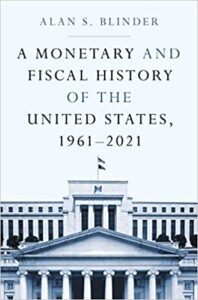A Keynesian's Macroeconomic History
By Arnold Kling


- One main reason why rational expectations macroeconomics, in particular its implication that the Phillips Curve for anticipated changes in money is vertical even in the short run, caught on was the allegation that the incumbent Keynesian tradition had failed to either control or explain high inflation. “Failed to control,” I suppose, is true, though the cost of stabilizing inflation in the face of huge supply shocks would have been devastating. But “failed to explain” was clearly a false charge once you gave Keynesian economists a few months to extend their framework to include supply shocks.
- Alan S. Blinder, A Monetary and Fiscal History of the United States, 1961-2021,1 p. 106-107
Macroeconomics is the study of fluctuations in key economy-wide indicators, such as unemployment, inflation, interest rates and Gross Domestic Product (GDP). Concerning methods for studying macro, my memoir says,
- Historians looking at the outbreak of the first World War can list possible causes. They can give reasons for paying attention to some factors more than others, perhaps based on analysis of other historical events. However, nobody would propose that a system of equations is the best way to summarize the factors that might have caused the war to break out. I think we ought to review and discuss historical events the way that historians review and discuss wars and revolutions. We need to take note of the various changes that take place in each decade that affect the way that the economy performs and the way that it responds to shocks and to policy interventions.
Blinder proceeds to undertake this sort of historical overview. This makes the book an excellent supplement, and perhaps a needed counterweight, to standard macro texts that focus on equations, often depicted in diagrams.
Blinder recounts dramatic policy moves, such as the Nixon Administration’s wage-price freeze of 1971, President Reagan’s tax cut, and Federal Reserve Chairman Paul Volcker’s battle against inflation. He also explains what economists were thinking at the time, with their ideas sometimes stimulated by events, and sometimes not. Finally, he interprets macroeconomic history through his preferred macroeconomic framework.
Blinder’s interpretations are those of an unreconstructed late-1970s textbook Keynesian. In this framework, there are three impulses that drive macroeconomic fluctuations. These are fiscal policy, monetary policy, and supply shocks. In fact, a better title for the book might have been A Monetary, Fiscal, and Supply Shock History of the United States, 1961-2021.
As he recounts the events and the ideas of economists, Blinder also describes the lessons that politicians learned. For example, it is important to try to avoid a slump during an election year.
- The fiscal inaction as the 1960-61 recession developed was particularly noteworthy because it greatly chagrined the Vice President, Richard M. Nixon…. Nixon believed that the recession cost him the 1960 election, and he may well have been right. p.9
In later decades, Jimmy Carter and George H.W. Bush would suffer similarly. But as President, Nixon pulled out all the monetary and fiscal stops in 1972 to make sure that there would be no recession. He won re-election in a landslide.
Another lesson learned was to outsource the responsibility for restraint to the Federal Reserve. In the 1960s fiscal stimulus to promote a stronger economy seemed to work, but at the end of the decade when fiscal restraint was called for, what was enacted was too little, too late.
- Finally, a die (of sorts) was cast. In theory, fiscal policy is symmetric. You raise taxes or cut spending to rein in aggregate demand, just as you cut taxes or boost spending to spur aggregate demand. In practice, however, fiscal policy in the future would be used (with rare exceptions) only to expand demand. When contracting demand was the order of the day, policy makers would turn to monetary policy instead, thereby taking the onus off politicians. p. 22
This worked out well for President Reagan, who could take credit for slashing tax rates while letting the Fed do the dirty work of fighting inflation. From Blinder’s perspective, fiscal policy and monetary policy at the time were working at cross-purposes, with the former expansionary and the latter contractionary. To the surprise of many Keynesians, monetary policy proved stronger, in part because of currency appreciation.
- The trade-weighted value of the U.S. dollar against a basket of other major currencies soared by 54 percent between September of 1980 and March of 1985…. As a share of real GDP, the trade deficit rose from roughly zero in 1980-1982 to about 2.4 percent of GDP in 1984 p. 146-147
In the three-impulse framework, it would be much better if fiscal and monetary policy worked together. But this only seems to happen when an expansion is called for. When inflation needs to be fought, Congress and the President refrain from doing any fighting.
I have my disagreements with Blinder. The one that I feel most strongly about concerns the use of statistically-estimated equations, or macroeconometric models. I was first exposed to some of their shortcomings the summer of 1975 when I was Blinder’s research assistant, and over the next several years I came to see them as suffering from fatal flaws. In my macro memoir I wrote,
- … macroeconomic data is not stationary, which invalidates many of the techniques used in macreconometric models, especially the use of lagged dependent variables.
- … A separate issue with econometric methods is raised in an iconoclastic book by Edward Leamer, called Specification Searches. Leamer points out that statistical theory assumes that the investigator engages in a single confrontation with the data. However, econometricians in practice try and fit many different specifications to the data, until the investigator is happy with both the quality of the fit of the equation to the data and also with the consistency of the findings with the investigator’s prior views. This process of searching for specifications makes results unreliable and lacking in objectivity.
Blinder continues to treat macroeconometrics as a scientific tool. I would caution readers that many economists distrust, with good reason, the sort of statistical analysis that he often cites.
My disagreement with the three-impulse framework is relatively milder. In fact, I prefer it to other frameworks, including Modern Monetary Theory3 or Market Monetarism4. But I think that there are many forces at work, and some of these are at least as important as fiscal policy, monetary policy, and supply shocks.
For example, there are secular trends. The interest rates that Blinder describes in the early chapters of the book will come as a shock to any reader who came of age in this century. Such readers will be amazed at how high the interest rates were that prevailed in earlier decades, even when inflation was low. The question of why interest rates have declined, and whether the decline is sustainable, is quite important, and it ought to worry policymakers.
Another issue of sustainability concerns the growth of government debt from about 25 percent of GDP in the 1970s to around 100 percent today, with a much larger share being held by the Fed. Under these circumstances, can higher interest rates be used to fight inflation in a way that does not severely disrupt financial markets?
Also, it seems to me that structural changes have taken place which probably affect macroeconomic performance and policy. The manufacturing sector is far less significant than it was in 1961, and within the service sector there is a growing disconnect between the fortunes of workers in the most menial jobs and those in the “laptop class.”
As Blinder points out, the financial sector was simpler in the 1960s. There was no interstate banking, far fewer index funds, mortgage securities, currency swaps, derivatives, or cryptocurrencies. Even in the early 1980s when Paul Volcker was sending interest rates close to 20 percent, it was illegal to pay interest on a checking account. It is highly improbable that the way monetary policy works now is identical to the way that it worked then.
The Internet has also changed the economy in many ways. I think it is unwise to keep relying on the three-impulse model without thinking hard about how these structural changes might have affected the way the economy behaves.
Blinder has harsh words for “rational expectations macroeconomics,” and I share his inclinations. But I would go further and say that we do not appreciate the extent to which economic outcomes, notably inflation, reflect the habits and beliefs of consumers and investors, nor do we understand the dynamics of how those habits and beliefs change. This reduces my confidence in any given macroeconomic framework.
For more on these topics, see
- “The Practitioner’s Challenge,” by Arnold Kling. Library of Economics and Liberty, July 3, 2017.
- Aggregate Demand, by Arnold Kling. Economics Topics Detail.
 Charles Calomiris on the Financial Crisis. EconTalk.
Charles Calomiris on the Financial Crisis. EconTalk.- Financial Crisis of 2008. Econlib College Guide.
The Financial Crisis of 2008 is the point where Blinder and I diverge. He interprets fiscal and monetary policy as if they were textbook stimulative impulses, executed using some novel tactics. Blinder sees the policy responses as a success, with the only drawback the ingratitude of the public.
In my memoir, I saw policymakers as doing something other than finding new ways to inject stimulus. While Blinder is comfortable characterizing the circumstances that prevailed in 2008 as a case of a textbook aggregate demand shortfall, it seemed to me that policymakers were making up a new theory of macroeconomics on the fly. Given that the theory of fiscal expansion favors broad-based measures to spur consumer spending and business investment, why did so much of the fiscal stimulus take the form of aid to specific corporations, especially banks? Given that monetary expansion is supposed to work by increasing bank lending, why was the Fed stuffing the banks with excess reserves, which by definition are not turned into loans? Blinder does not raise such questions, much less answer them. In my memoir I agonize over them, trying and failing to work backwards from the policy responses to infer a theory behind them. I also struggle to develop and articulate an alternative to the three-impulse framework.
I believe that economics students will derive considerable value from reading Blinder’s Monetary and Fiscal History. And I hope that some of them also choose to read my macro memoir alongside it, to see where our perspectives overlap and where they differ.
Footnotes
[1] Alan Blinder, A Monetary and Fiscal History of the United States, 1961-2021. Princeton University Press, 2022.
[2] Arnold Kling, “Memoirs of a Would-be Macroeconomist.” PDF file. (Or google “Arnold Kling macro memoir”.)
[3] Arnold Kling, “Deficits—Budgetary and Conceptual.” Law and Liberty, July 17, 2020.
[4] Arnold Kling, “If I Were a Market Monetarist.” Library of Economics and Liberty, November 1, 2021.
*Arnold Kling has a Ph.D. in economics from the Massachusetts Institute of Technology. He is the author of several books, including Crisis of Abundance: Rethinking How We Pay for Health Care; Invisible Wealth: The Hidden Story of How Markets Work; Unchecked and Unbalanced: How the Discrepancy Between Knowledge and Power Caused the Financial Crisis and Threatens Democracy; and Specialization and Trade: A Re-introduction to Economics. He contributed to EconLog from January 2003 through August 2012.
Read more of what Arnold Kling’s been reading. For more book reviews and articles by Arnold Kling, see the Archive.
